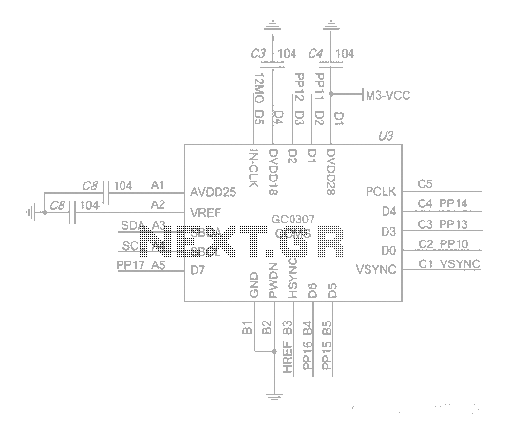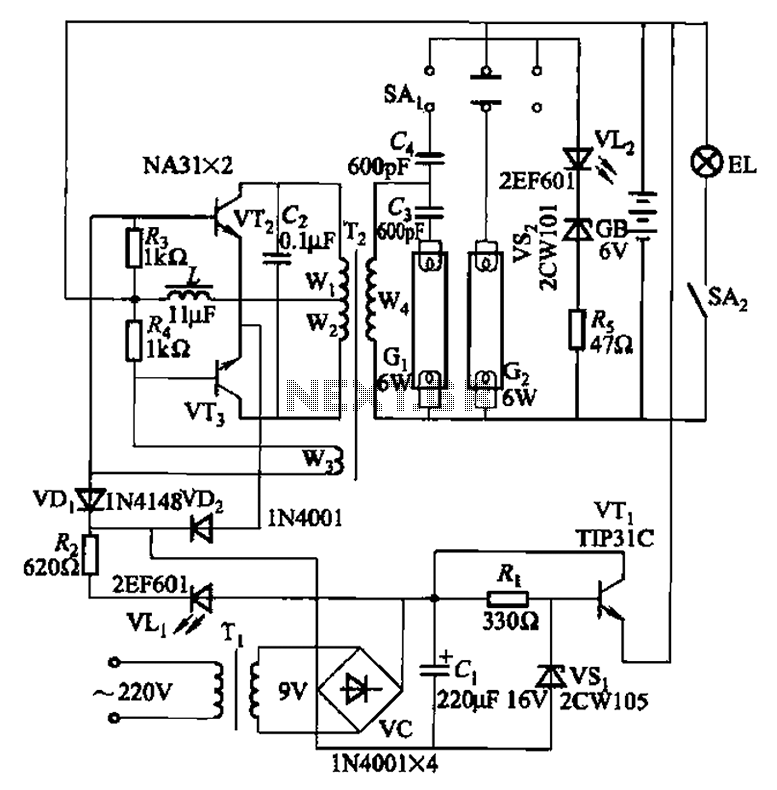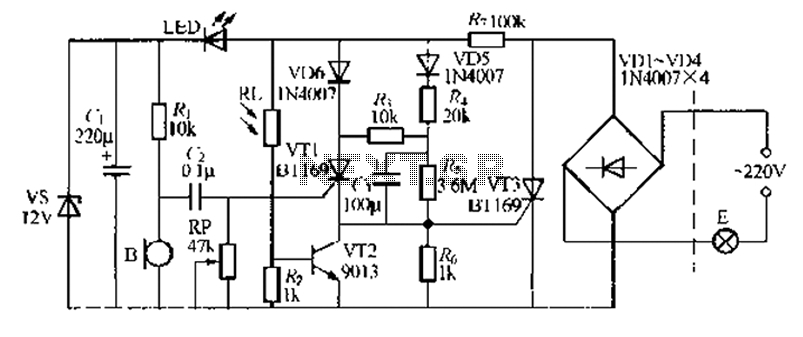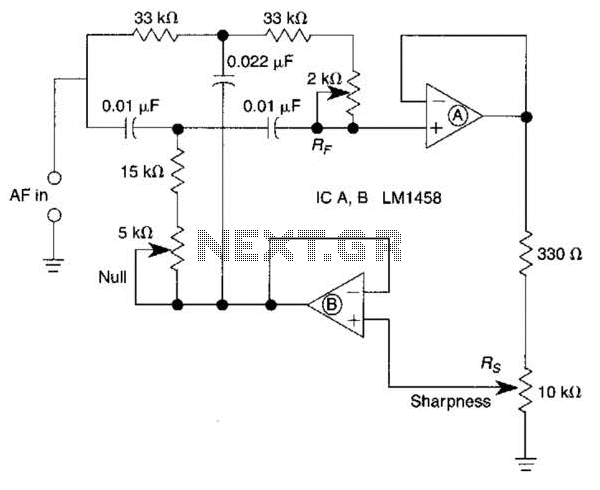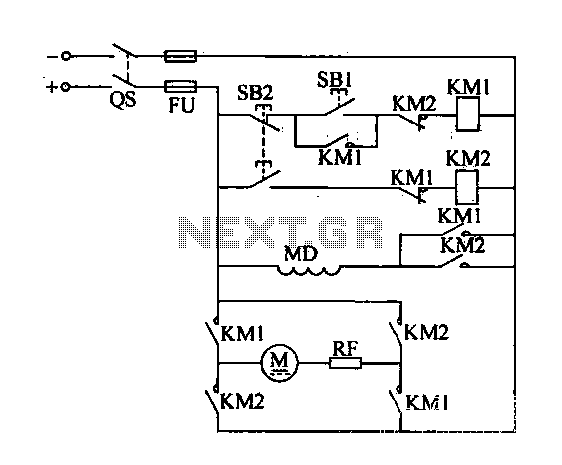
Automatically Repeating Interval-Timer Circuit
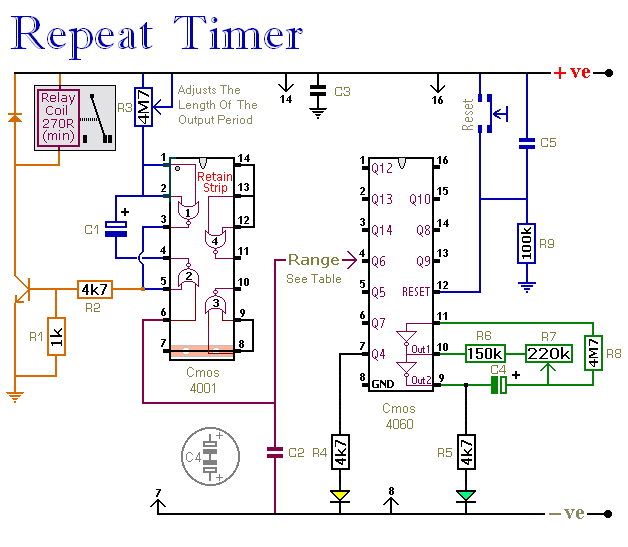
The CMOS 4060 integrated circuit (IC) features two built-in inverters located at pins 9, 10, and 11, which must be interconnected to create an oscillator. The output of this oscillator is available at Pin 9, which continuously alternates between high and low states, akin to the motion of a pendulum or the ticking of a clock. The frequency of the oscillation is regulated by resistors R6, R7, and capacitor C4, which are connected in series between the outputs of the two inverters. When the cycle initiates with Pin 11 in a low state, Pin 10 will be high, and Pin 9 will be low. Consequently, the capacitor begins charging from Pin 10 through R6 and R7. The charging speed is determined by the capacitor value and the setting of R7. As the capacitor charges, the voltage at the junction of C4 and R7 increases. Once this voltage exceeds half the supply voltage, Pin 11 transitions to a high state via R8, reversing the conditions: Pin 11 becomes high, Pin 10 low, and Pin 9 high. The capacitor C4 then charges in the opposite direction, and the voltage at the junction of C4 and R7 decreases. When this voltage drops below half the supply voltage, Pin 11 returns to a low state through R8, completing the cycle and allowing the next cycle to commence. The oscillator operates due to the continual reversal of charge polarity on C4, which causes the junction of C4 and R7 to toggle Pin 11 between high and low states, creating a controlled feedback mechanism. The frequency generated is influenced by the values of R6, R7, and C4. R6 is primarily responsible for setting an upper frequency limit, with its value selected to yield a minimum period of approximately 30 seconds at Pin 7. R7 is set to provide a maximum period exceeding 12 hours at Pin 3, allowing the timer to be configured for re-triggering intervals ranging from one minute to at least 24 hours. Given that the charge on C4 is constantly reversing in polarity, a non-polarized capacitor is ideally preferred; however, standard polarized electrolytic capacitors can often be utilized due to their low leakage current in the reverse direction. The combined minimum value of R6 and R7 is 150k, resulting in minimal current flow through the resistors, meaning that even if C4 experiences leakage in the reverse direction, the oscillator may still function. The oscillator's operation can be easily verified by setting R7 to a midpoint; if a green LED connected to the circuit blinks on and off at approximately 3-second intervals, the oscillator is functioning correctly. R6, R7, and R8 are connected in series between Pins 10 and 11, linking the output of the first inverter to its own input. R8 must possess a high resistance value to ensure that the output influence from the first inverter on its input remains minimal, allowing the varying charges on C4 to dominate. The datasheet for the 4060 specifies that R8's value should be at least ten times that of R6 plus R7. A resistor value of 4.7 MΩ is commonly used due to its availability. Such high-value resistors are suitable because CMOS inputs operate based on voltage rather than current, resulting in no current flow through R8 and thus no voltage drop across it. The CMOS 4060 serves as a 14-bit binary counter, with the oscillator's output connected internally to the counter, which counts the oscillations. The count state is reflected by the output pins; for instance, after eight oscillations, Bit 4 at Pin 7 will go high, after sixteen oscillations, Bit 5 at Pin 5 will go high, and after thirty-two oscillations, Bit 6 at Pin 6 will go high.The Cmos 4060 IC has two built-in inverters - at pins 9, 10 and 11. They must be wired together to form an oscillator - the output of which is at Pin 9. While the oscillator is running - Pin 9 is switching continuously from high to low and vice-versa. It`s rather like the swing of a pendulum - or the ticking of a clock. The speed at which the osci llator ticks is controlled by R6, R7 & C4. = Note that R6, R7 & C4 are connected in series between the outputs of the two inverters. If the cycle starts with Pin 11 low - then Pin 10 will be high - and Pin 9 will be low. So the capacitor will begin to charge from Pin 10 - through R6 & R7. The speed at which it charges depends on the value of the capacitor - and the setting of R7. As the capacitor charges - the voltage at the junction of C4 & R7 will rise. When it reaches just over half the supply voltage - it takes Pin 11 high - through R8. = Now everything reverses. Pin 11 is high - so Pin 10 is low - and Pin 9 is high. C4 begins to charge again - only this time it`s in the opposite direction. As Pin 9 charges the capacitor - the voltage at the junction of C4 & R7 will fall. The speed at which it falls depends on the value of the capacitor - and the setting of R7. When it falls to just below half the supply voltage - it takes Pin 11 low - through R8. With Pin 11 low the cycle is complete - and the next cycle can begin. = The oscillator runs because the polarity of the charge on C4 keeps reversing. As a result - the junction of C4 & R7 keeps taking Pin 11 back and forth between high and low. And since Pin 11 keeps changing back and forth between high and low - the polarity of the charge on C4 keeps reversing. It`s a sort of controlled feedback - where the frequency generated is determined by the values of R6, R7 & C4.
= The main purpose of R6 is to set an upper limit on the frequency. Its value was chosen to provide a minimum period of about 30 seconds at Pin 7. The value of R7 was chosen to provide a maximum period in excess of 12-hours at Pin 3. This means that the timer can be set to re-trigger at intervals of anything from one minute up to at least 24-hours. = Since the charge on C4 is constantly reversing in polarity - ideally the capacitor should be non-polarized.
However - modern electrolytic capacitors generally have a very low leakage current - even in the reverse direction. So you can usually get away with using a regular polarized electrolytic capacitor. = Because the minimum value of R6 + R7 is 150k - very little current will flow through the resistors.
So - even if C4 does leak in the reverse direction - the worst that can happen is that the oscillator won`t run. = It`s easy to tell if the oscillator is running. Set R7 at about mid-point. If the green LED is turning on and off at about 3-second intervals - the oscillator is working properly.
= Note that R6, R7 & R8 are connected in series between Pins 10 and 11. They join the output of the first inverter to its own input. The value of R8 needs to be very high. That way - any influence the output of the first inverter has on its own input will be very small. It will be swamped by the influence of the changing charges on C4. = The data sheet for the 4060 says that the value of R8 should be at least ten times the value of R6 + R7. A 4M7 resistor was chosen because they`re widely available. It`s possible to use such high value resistors because Cmos inputs are operated by voltage - and not by current.
Because no current flows through the R8 - there`s no voltage drop across it. = The Cmos 4060 is a 14-bit binary counter. The output from the oscillator is connected internally to the counter. And the counter counts the number of oscillations. = As it does so - the state of the count is reflected by the output pins. For example - after 8 oscillations - Bit 4 at Pin 7 will go high. After 16 oscillations - Bit 5 at Pin 5 will go high. After 32 oscillations - Bit 6 at P 🔗 External reference
= The main purpose of R6 is to set an upper limit on the frequency. Its value was chosen to provide a minimum period of about 30 seconds at Pin 7. The value of R7 was chosen to provide a maximum period in excess of 12-hours at Pin 3. This means that the timer can be set to re-trigger at intervals of anything from one minute up to at least 24-hours. = Since the charge on C4 is constantly reversing in polarity - ideally the capacitor should be non-polarized.
However - modern electrolytic capacitors generally have a very low leakage current - even in the reverse direction. So you can usually get away with using a regular polarized electrolytic capacitor. = Because the minimum value of R6 + R7 is 150k - very little current will flow through the resistors.
So - even if C4 does leak in the reverse direction - the worst that can happen is that the oscillator won`t run. = It`s easy to tell if the oscillator is running. Set R7 at about mid-point. If the green LED is turning on and off at about 3-second intervals - the oscillator is working properly.
= Note that R6, R7 & R8 are connected in series between Pins 10 and 11. They join the output of the first inverter to its own input. The value of R8 needs to be very high. That way - any influence the output of the first inverter has on its own input will be very small. It will be swamped by the influence of the changing charges on C4. = The data sheet for the 4060 says that the value of R8 should be at least ten times the value of R6 + R7. A 4M7 resistor was chosen because they`re widely available. It`s possible to use such high value resistors because Cmos inputs are operated by voltage - and not by current.
Because no current flows through the R8 - there`s no voltage drop across it. = The Cmos 4060 is a 14-bit binary counter. The output from the oscillator is connected internally to the counter. And the counter counts the number of oscillations. = As it does so - the state of the count is reflected by the output pins. For example - after 8 oscillations - Bit 4 at Pin 7 will go high. After 16 oscillations - Bit 5 at Pin 5 will go high. After 32 oscillations - Bit 6 at P 🔗 External reference
